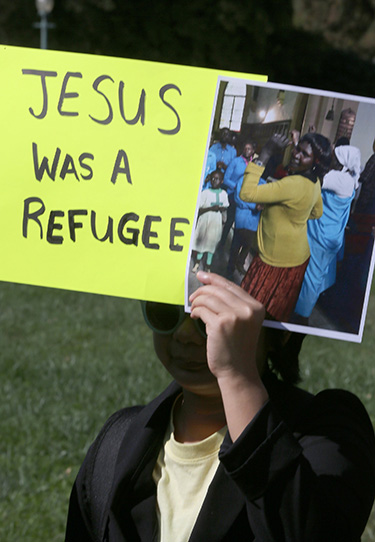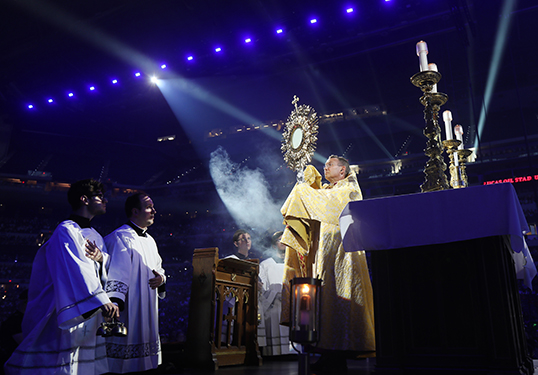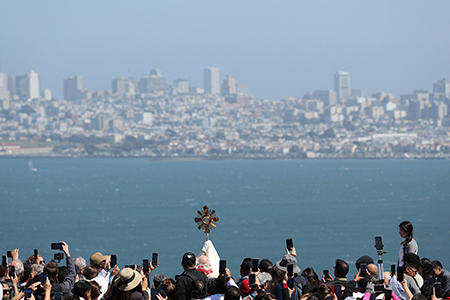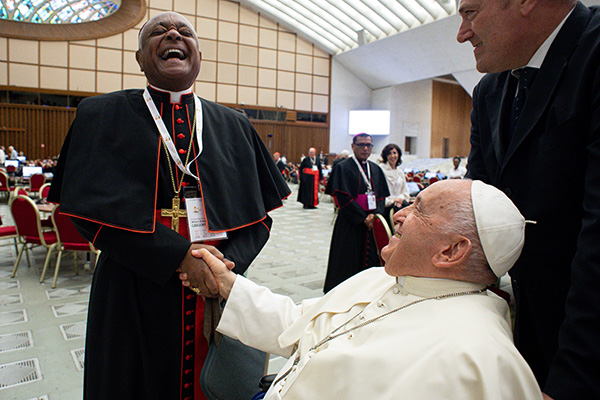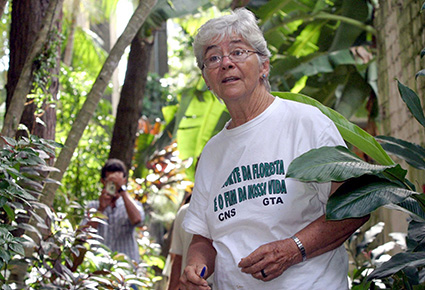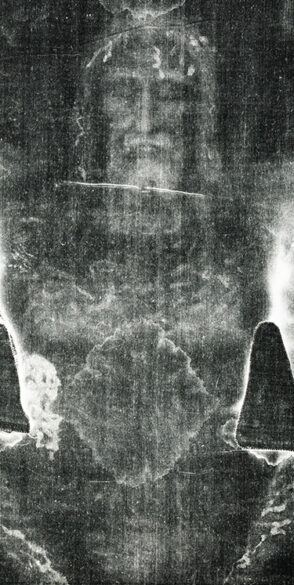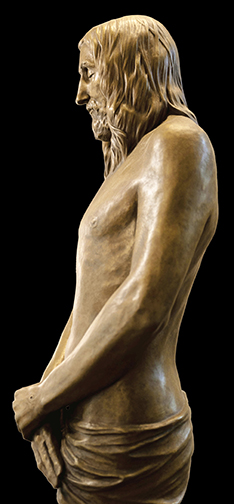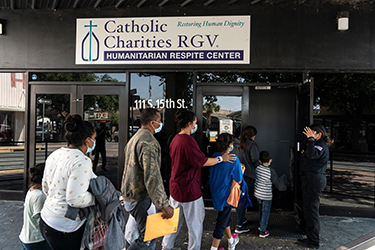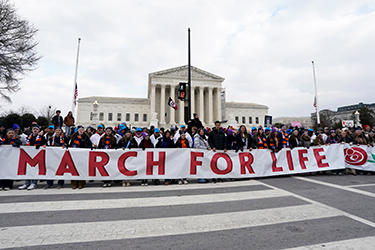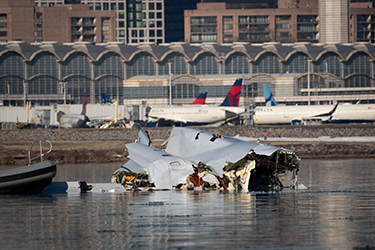By Tom Hoopes
(OSV News) – We sell our faith short, and so we sell our Lent short. At least I do.
I have spent most of my life thinking of the faith as a series of rules I have to live in conformity with. Don’t get me wrong: I knew that the rules themselves were not the goal – they were a path to God’s will, and therefore to God’s love, and therefore to happiness.
But our faith is not just about union with God’s will, it’s also about union with Jesus Christ – “For the Son of God became man so that we might become God,” as St. Athanasius put it. God is love, a love so powerful he wants to be one with us. He became man to make that possible – and he made the sacraments, especially baptism, to make it happen.
I used to live Lent as a way to build my spiritual muscles to be able to do God’s will better. Now I do exactly the same things I always did, but with a new intention: to become one with Jesus Christ.
Baptism guarantees that this is possible. If we cooperate with baptismal grace, the sacrament guarantees that we can “participate in the divine life of the Trinity” first of all by receiving the theological virtues: faith, hope and love.
- Pray with Christ in the desert to gain his faith
Be explicit about it: Imagine yourself next to Jesus in the desert; or imagine him joining you wherever you pray. Jesus is God, so he is outside time and space. Spiritual masters like St. Ignatius of Loyola say we are free to use our imaginations not because it’s helpful to pretend Jesus is with us, but to help our minds acknowledge what is true.
One of the points Father Mike Schmitz has stressed several times in his “Catechism in a Year” podcast is that Christianity is not a “religion of the book” but a “religion of the Word.” Faith isn’t merely an assent to a proposition; it’s a relationship with a person – Jesus Christ, the Word made flesh.
Think of him this way: God is goodness, truth and beauty itself, such that God’s light shines through all we see, as if the surface of the world were a stained glass window aglow with the presence of God who stands behind it all. Jesus Christ is the light of the world who collects in one place all the greatness we see elsewhere. Spend time next to him in the desert, where he shines brighter than the desert sun.
Lord Jesus, give us the faith that will allow us to see your presence, essence and power everywhere in all the things that you made. - Fast with Jesus Christ in the desert to learn hope
It is the Holy Spirit, the consoler, that leads Jesus into the desert in the Gospel for the first Sunday of Lent. This reveals what real consolation looks like. The Holy Spirit doesn’t console us by telling us that our life here on earth is just fine. He consoles us by telling us that we have a deeper relationship that keeps us rooted and steady as storms rage.
Lent consoles us the same way. It’s true that fasting helps build our self-control while weakening our appetites, and that’s good. But the ultimate reason we fast is to connect us with that deeper hope, said Pope Benedict XVI.
“When we attempt to avoid suffering by withdrawing from anything that might involve hurt,” he wrote in “Spe salvi,” his encyclical on hope, “we drift into a life of emptiness, in which there may be almost no pain, but the dark sensation of meaninglessness and abandonment is all the greater. It is not by sidestepping or fleeing from suffering” that we find hope. (No. 37)
Fasting takes away our desire to say “Everything is awesome!” and teaches us to say, instead: “Though I walk through the valley of the shadow of death, I will fear no evil, for you are with me” (Ps 23:4).
Lord Jesus, as we sit with you in the desert, give us a share in the spiritual hope that only grows as our false, material hopes wane. - Give alms to grow in love for the suffering Jesus
One thing you learn as a parent is how unfairly partial you are to your own children. You see your children as more special than others, more beautiful and more deserving of the good things offered in life. This happens because they are yours and share in your image.
The same thing happens with God. Everyone you see is someone who he made, in his image and likeness – someone he would become man for; someone he would die for. He loves them each and loves to see you love them too.
Therefore, to become like Jesus, you have to see Christ in others. Mother Teresa, the saint of charity, shared what she called “The Gospel on five fingers”: You. Did. It. To. Me. This was the criteria Jesus the Judge will use at the end of time: “Whatever you did for one of these least brothers of mine, you did for me.” (Mt 25:40)
Lord Jesus, as we give alms this Lent, help us console you in the people you identify so closely with that in serving them we serve you. - Pray the Stations of the Cross to see with Jesus’ wisdom
In addition to the three theological virtues, baptism guarantees we will receive the seven gifts of the Holy Spirit.
The priest who confirmed me said that if I don’t receive faith, hope and love, I should demand them from God. “God promises you these graces,” he said. “Hold him to it.” It’s the same, he said, with wisdom, understanding, knowledge, counsel, fortitude, fear of the Lord and piety.
To remember the seven gifts of the Holy Spirit, I think in terms of my body, starting with the eyes: Wisdom is the gift of seeing things as Christ sees them.
The “Via Crucis” (Way of the Cross) celebration in your parish is a great way to gain this grace. Again, use your imagination. Yes, you are standing in the back of a church, craning your neck to see each station, looking from your book to the tabernacle to the altar server holding the crucifix. But you are also standing in the crowd at Jerusalem that came to see a spectacle. Pray to have the vision they lacked, the vision to see through the spectacle to its deepest meaning. And pray to realize you aren’t just watching Christ; he is gazing with love on you.
When Jesus Christ sees Pilate on the way of the cross, he sees his dignity and appeals to that. When he sees his mother, he is encouraged by her fidelity. When Simeon is seen by Christ, it changes the trajectory of his life. When Veronica is seen by him, he leaves his image with her.
Lord Jesus, help us enter into the Stations of the Cross deeply so that we see with you and are seen by you. - Do spiritual reading to think with Christ’s understanding
The gift of understanding is the holy insight that lights up your brain. If a passage of the Bible has ever jumped out at you and convicted you, if a homily’s words have ever cut you to the heart, if you ever felt like you finally “got” what life is all about for one fleeting moment – you have experienced the Holy Spirit’s gift of understanding.
A shortcut to this gift is to share in the understanding of others through spiritual reading.
Catholics in the 21st century have a gift that our predecessors in the faith never even dreamed of: Almost any book we can think of can be delivered to our door this week or appear on our phone in electronic form instantly. We can summon Thomas Aquinas to our hand; at any time, we are moments away from reading or listening to the words of C.S. Lewis, Fulton Sheen or Bishop Robert Barron. We can deepen our understanding starting now, through a podcast or a spiritual classic.
Lord Jesus, fill our minds with your understanding through our relationship with you and those who came before us in the Faith. - Attend Mass to imbibe Christ’s knowledge
The purpose of life is to know, love and serve God. To know him means to know things about him, but it also means to “have knowledge” of him in the Biblical sense: to unite with the body of Christ. That means that the Catholic Mass’s Liturgy of the Word and Liturgy of the Eucharist are a summing up of one of our whole life’s tasks.
There are two remarkable passages in the Bible recounting mystical visions of sharing in Christ’s knowledge. In one, the prophet Ezekiel is given a scroll to eat; in another, St. John the Evangelist is given the same. We have this gift not in a vision but in reality through Scripture and Communion at each Mass.
Lord Jesus, give us the gift of receiving you deeply at each Mass, through our ears and on our tongues. - Give something up so that your heart grows in Christ’s fortitude
Giving something up is a Lenten tradition for a reason. I was deeply convicted by a friend’s Facebook post three years ago that asked: “What is it that you won’t give up, even for God?” We all have something in our life – eating, drinking, shopping, entertainment, social media – that we rely on for comfort and meaning, something we are afraid to live without.
Think of all the things lovers give up to make their beloved first in their lives: their own preferences, their personal time, and the money they would have spent on themselves. Think of all the things parents give up because their children become first in their lives: their days and nights, their travel plans and their future plans. They give them up gladly for the person their heart loves most.
Jesus, love gives us the fortitude to give things up for those we love. Give us the fortitude to give up that thing that most keeps us from you. - Live Ash Wednesday, Fridays and Good Friday to walk in Christ’s counsel
Think of counsel as the Holy Spirit’s GPS system. It allows you to judge where to go and how to act almost by intuition. This doesn’t happen magically; it happens by building the habit of following God’s will, which is expressed in his church. The precepts of the church are here to help give us that habit: Fast with Jesus as the church asks on Ash Wednesday and Good Friday, abstain from meat on Fridays in union with his sacrifice, and more.
To see how powerful the church’s life is, think of the deep nostalgia Catholics feel every year not just at Christmas, but also at Lent. Maybe we remember wearing ashes to school as a kid. Maybe we remember fish sticks, rice and ketchup on Fridays. We remember the strangeness of the empty tabernacle in church on Good Friday and the mystery of the candles at Easter Vigil. That nostalgia is the church’s life moving into my soul, telling me I belong to Jesus and that I can rest in him through the life of the church.
Lord Jesus, you gave us your church as a way to train us to walk in your path. Give us the grace to walk in fidelity to your church and to you. - Pray the Rosary to join Christ in his fear of God and piety
If we are going to share in the life of the Trinity through Christ, the two final gifts of the Holy Spirit are indispensable. Jesus prays, “Father, glorify your name!” to show us fear of God, awestruck respect for his majesty (Jn 12:28). He also prays “Abba, Father!” calling God “papa” or “daddy” to show us piety, the sweet consolation of closeness with God.
The person who best exemplifies life in Christ is Our Lady, who carried Christ in her womb. In the joyful mysteries of the rosary, she makes Christ the center of her life and brings him to others. In the final glorious mysteries, she is given the awe-inspiring gifts of being welcomed at Christ’s side in heaven as a queen. In between are the sorrowful mysteries.
The Lenten song that for me best demonstrates fear of the Lord and piety is “Stabat Mater”: “At the cross her station keeping.” The song shares the awe and gratitude at the great act of majesty and closeness that Christ made on the cross.
Lord Jesus, let me kneel with your mother in awe at your majesty and fold my hands with her in appreciation at your closeness. - Recommit to your baptism on Easter, ready to become one with Jesus
Spoiler alert: At the end of Lent, you will be renewing your baptismal promises at Easter Mass. It turns out that renewing your baptismal graces is what Lent was about all along.
“All Christ’s riches ‘are for every individual and are everybody’s property,’” says the Catechism of the Catholic Church (No. 519). The more we give to Lent, the more it will conform us to Christ, and that is truly the greatest happiness available on earth or heaven.
To live Lent better, you don’t have to do anything extraordinary, you just have to live Lent’s practices with this end in mind.
Lord Jesus, every year I renew my baptismal promises at Easter. This year I want to be more prepared for that moment than ever before. Kindly give me the graces in Lent that will unite us at Easter.
(Tom Hoopes, author of “The Rosary of Saint John Paul II” and “The Fatima Family Handbook,” is writer in residence at Benedictine College in Kansas and hosts “The Extraordinary Story” podcast on Ex Corde.)

